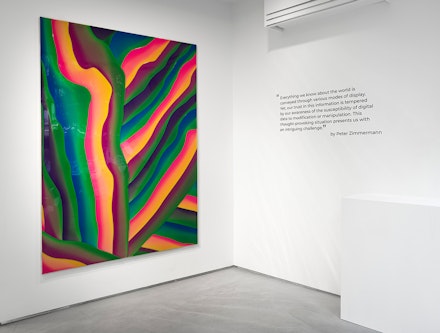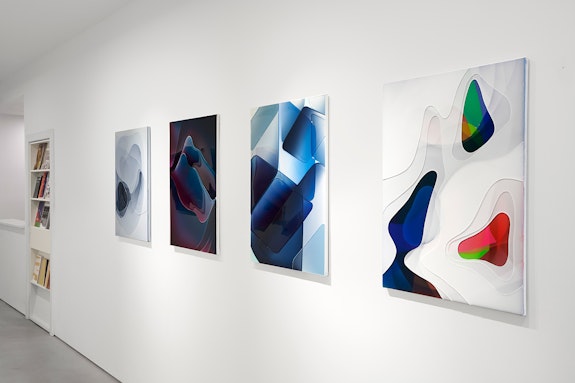ArtSeen
Peter Zimmermann: Virtual Paradigms

On View
Nunu Fine ArtPeter Zimmermann: Virtual Paradigms
September 5 – November 4, 2023
New York
How do you feel about pretty pictures? The question is unavoidable when one enters Virtual Paradigms, Peter Zimmermann’s show of abstract epoxy resin paintings on view through November 4 at Nunu Fine Art on Manhattan’s Lower East Side. Sparsely and dramatically spaced on the walls hang sixteen large- and medium-sized canvases that feature slick surfaces, broad gooey shapes, and candy-sweet colors. At the entrance, adjoining a composition of wavey green, orange, and blue stripes, a wall text offers the artist’s claim that these works reflect the mind-conditioning effects of today’s ubiquitous digital media.
At a September 14 gallery dialogue with critic and art historian Charlotte Kent, Zimmermann was candid about his working method. As in the classic Color Field paintings of Frankenthaler, Louis, and Noland, the forms are poured and manipulated, but Zimmermann’s viscous material requires a highly premeditated handling. The artist begins by deliberately glitching digital files, then color-separates the resulting patterns in Photoshop and projects them onto canvas. He outlines the shapes—rectangular, elongated, landscape-ish, or biomorphic—using adhesive tape to confine each chromatic area until it dries overnight. Sometimes the forms interlock, sometimes they are layered. There may be as many as thirty pours per picture.
One could make a case for this 2023 body of work as neo-Process Art. Much harder to decipher, however, is why the Cologne-based artist does what he does. His principal theme, he told Kent, is a query: “How are our perceptions created?” In the late 1980s, influenced by the institutional-critique practices of Context Art, Zimmermann made paintings that directly mimic the way book covers condition readers’ expectations and responses. But now, subject like the rest of us to the pervasive mesmerism of screen culture, he seeks to evoke the conceptual parameters, insidious algorithms, and baked-in software biases of the digital technology that largely determines how we apprehend the world in the twenty-first century. This generative premise updates Kant’s notion that we can “know” reality only as it is conveyed via certain innate perceptual and logical modalities (space, time, causality, negation, etc.). Now, our human filters are overlain and redoubled by technological filters. Hence, as a critique, these paintings that look like frozen screensavers.
Zimmermann’s rationale, more easily heard and read than seen in the work, still leaves the problem of prettiness. Fear of kitsch abstraction, real or alleged, is all around us: look no further than Refik Anadol’s goopy, seething AI wall at MoMA or the Whitney’s 2009 exhibition Georgia O’Keeffe: Abstraction. Both presentations spurred controversy. But for whom is easy viewing an issue?
Certainly, a considerable portion of the casual art-viewing public, an audience that is pleased to be pleased, will simply enjoy Zimmermann’s works for the valentines they appear to be. Statistically, uptight art-world-insider skepticism is a minority affect (or, when faked, mannerism), a cognitive triumph attained by first suppressing an innate pleasure response. In effect, we cognoscenti have given up the simple gratification of loving bright shapes for the “higher,” more complex gratification of disdaining the uninitiated.
But can we really pretend there is such a thing as “cutting-edge” taste anymore, when avant-garde principles have been, paradoxically, sacred aesthetic doctrine for more than a century? Early in the modernist era, certain artists (Renoir, Monet, Bonnard, Matisse) got a pass on the prettiness issue because their work contributed to a larger revolutionary agenda—the fracturing of the picture plane, the exploration of psychological time, the liberation of form and color from the chains of indexical representation. Fellow rebels could not accuse these painters of visual pandering without putting the entire anti-academic revolt in jeopardy. But once that insurrection succeeded, sweeping aside every vestige of classical beauty, once the “terribleness” of the sublime as theorized by Kant and Edmund Burke became an aesthetic virtue, once Duchamp pronounced anathema on mere “retinal” art, the old camaraderie shattered.

These days, given the inglorious demise of Op art and Finish Fetish, serious artists dare not make gorgeous work without being foxy about it. (Consider the various it’s-really-something-else stratagems of Takashi Murakami, Yayoi Kusama, James Turrell, and Mark Bradford.) Zimmermann—who studied at the State Academy of Fine Arts Stuttgart and taught at the Academy of Media Arts in Cologne—surely knows the critical ground rules. In Asia, his work is esteemed in the press and the marketplace; in Europe, he is written about respectfully, almost reverentially, by established scholars and critics. It is only in the Americas that hesitation lingers.
For decades before his adoption of the glossy resin medium, Zimmermann produced more conventional oil-on-canvas abstractions, all of them luscious. Could it be that he is now doubling down, layering irony upon irony, in the face of doubters and naysayers? Or does he simply dismiss the skeptics, finding their objections elitist and obsolete?
Strictly speaking, what goes on in the soul of the artist is irrelevant; all that matters is the effect of the work on its viewers. Thus, the greatest value of Virtual Paradigms may lie in what these vibrant paintings tell us about our own deeply conflicted, sometimes hypocritical selves, and our cognitively dissonant position in the ever-changing history of taste.


